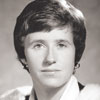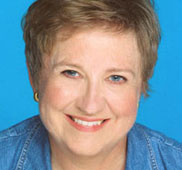They arrived at law school in the mid seventies having done their reading - The Feminine Mystique, The Female Eunuch. As their numbers increased steadily - from about 10 percent in '73 to about 25 percent by the end of the decade - the school felt the impact. Dean Martin Friedland appointed many of the school's first female law professors, and introduced curriculum changes (including interdisciplinary legal studies) that would nudge the study of law into a new era.They are the firecrackers, the trailblazers, the ones who got the whole ball rolling - just a few of the definitions the women who went to law school in the 1970s offer up of their generation.

Lorraine Weinrib |
This generation brought new ideas with them - that gender did matter and that law was hardly a neutral instrument. "It was a male culture, but there was an assumption that it was neutral," says Lorraine Weinrib ('73) who went on to litigate extensively in the Supreme Court and teach the Canadian Charter at U of T. "In one criminal course, all the examples were rape cases and the professor talked jocularly about it - oops, Flossie got raped again."
But one of the first gender issues women raised was, well, on the subject of bathrooms. The law school had precisely two stalls. "It was hard for us all to use the facilities in the 20 minute breaks we had," laughs Weinrib. "Someone invariably had to go to the associate dean to ask for more toilet paper."
Yet, the increasing number of women was proving a real threat - not just to the plumbing but to the conservative old-boys nature of the profession. Weinrib says resentment simmered among both professors and male students. "One of my classmates told me outright that I shouldn't be in the class because I was taking the place of his friend who was highest on the waiting list."

Maureen Kempston Darkes |
Maureen Kempston Darkes ('73), who later became GM Group Vice President and President, GM Latin America, Africa and the Middle East, says the greatest challenge in the seventies was "being taken seriously. The sense was, aren't you just going to get married? But we were there for a purpose and we had every intention of having a serious career."
Indeed, Jean Fraser ('75), who became a leading corporate finance specialist and senior partner at Osler, Hoskins & Harcourt, joined a study group that included future bright lights Rob Prichard and David Cohen, who would become deans of law at U of T and Pace University respectively. The group would stay together through three years. "We kicked around stuff beyond the black letter of the law, often in the middle of the night over our eighth pizza," says Fraser. "I think it helped me apply law, which is really what lawyering is all about. It was the first taste of what it would be like to have professional colleagues. I just loved the whole challenge."

Jean Fraser
|
For the first time, women graduated to open doors and opportunity. At least officially, the legal profession said they wanted more women in their firms and went recruiting. Says Fraser: "The larger law firms were falling all over themselves to hire women, and they were run in such a fashion that gave us real opportunity. In a way, we were beneficiaries of affirmative action, but the benefit didn't last very long."
Nor did the honeymoon. These "lady lawyers," as they were often called, began opening eyes from the first day on the job. Weinrib says her male colleagues actually discussed whether she should be, along with their secretaries, rotated in to relieve the receptionist at lunch. "Gender identity was stronger than my legal qualifications."
Traveling with a male colleague for work on a case was also questioned, making it difficult for a woman to get work on interesting cases. Announcing pregnancies often provoked angry outbursts from mentoring lawyers, who felt they had wasted time on training. In court, Weinrib says she endured occasional taunts, being called Mr. Weinrib or, when she was obviously pregnant, Miss Weinrib. "I thought at one point that being a woman is such a burden. I'd come home and dump on my husband (U of T law Professor Ernie Weinrib) and he'd say, 'no one would ever say that to a man.' But I would somehow feel emptied and he wouldn't be able to sleep all night."
Tough as the times were, the trailblazers also reported having exceptionally supportive male mentors - crucial to moving into senior ranks. And their careers were on the fast track, so much so that many women were reluctant to step off for children, becoming the "super moms" of the eighties. Fraser says she managed by "hiring help to do everything that you could possibly farm out to someone else… It's one of the benefits of a decent income, though I wasn't sure I was making much after I paid everyone."

Kirby Chown |
After acquiring a substantial number of firsts - to be hired by their firm, to have children, to appear in the Supreme Court, to become partners - these women started pushing for change. Kirby Chown ('79), who became a managing partner at McCarthy Tétrault, says she studied the male culture of her law firm "almost as a tourist" for the first few years. "Law was behind on issues focusing on women. But with about five years under my belt, I began to appreciate the power I had." With twins at home, she set boundaries around her personal time while she and other women advocated for flex time and more progressive policies for both maternity and paternity leaves. "I felt strongly about things and more able to speak out…. You had to be willing to be farther out there, to raise issues, and also to practice effectively and show leadership…. The ability to speak up and advocate for changes within your own work setting is a quality that should be accepted and admired as a mark of leadership."
Chown says women also brought a different approach to the practice of law, especially in her field of family law. "The male model was advocacy - we're going to trial. Now we have a whole structure in Ontario that encourages mediation and alternative dispute resolutions. Womens' style tends to be more resolution seeking through consensus building and that's had a profound effect on dispute resolution."
And then, of course, there is the sheer contribution they made as role models. Weinrib recalls arguing a case in the Supreme Court in 1982 when Bertha Wilson was appointed its first female judge. After an interruption, the court returned and made the announcement. "When they came back, I think some were not happy. But I was overwhelmed with this very, very positive feeling that I would no longer be the only woman in the courtroom."





